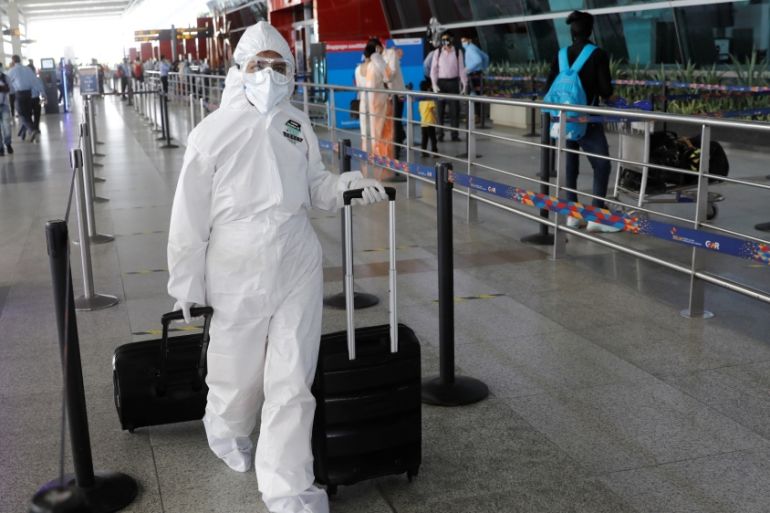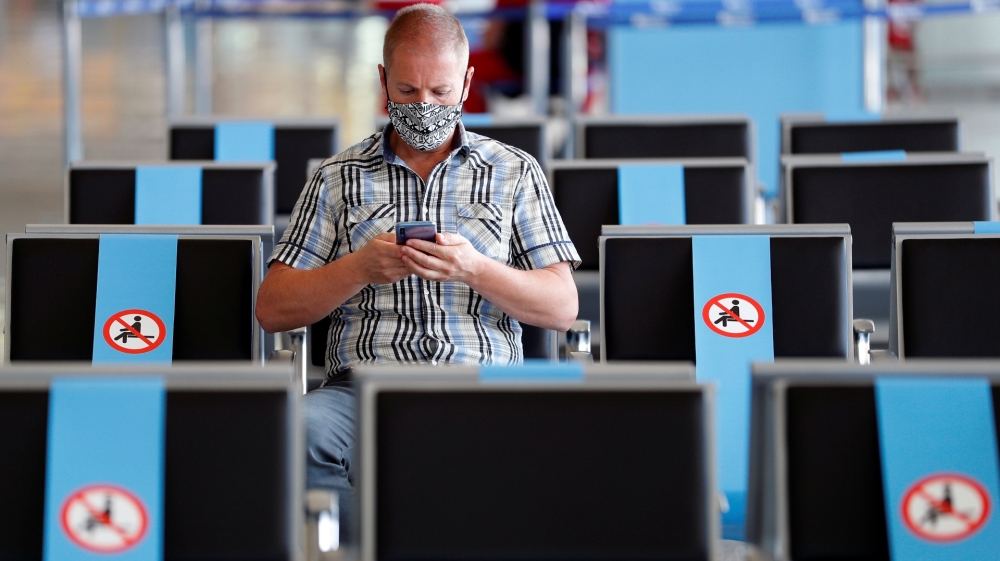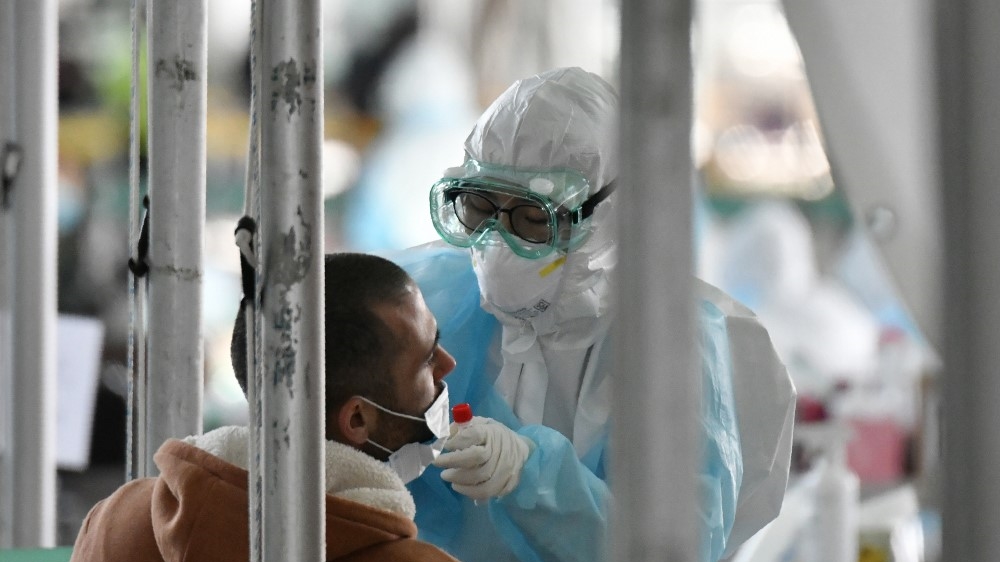Why the coronavirus is going to make flying even more stressful
Physical distancing remains the best defence against the coronavirus, but it may not allow airlines to make a profit.

“Uncomfortable.”
“It really felt like Armageddon – the end of days.”
Keep reading
list of 4 itemsMexico’s teachers seek relief from pandemic-era spike in school robberies
‘A bad chapter’: Tracing the origins of Ecuador’s rise in gang violence
Why is the US economy so resilient?
“I wore a mask for 12 hours – it was suffocating.”
“Just don’t travel unless you absolutely have to.”
This is how four people who flew recently described what it is like to travel by air during the coronavirus pandemic.
With good reason. The hodgepodge of measures airlines and airports have put in place to prevent passengers and crew from spreading the virus has made the experience of flying more stressful than it was before the pandemic.
For instance, in Thailand, travellers are subjected to temperature checks before they can enter airports.
In many United States departure terminals, chairs are blocked to enforce physical distancing and signs on the floor tell passengers to stand six feet apart. Announcements over the public address system remind travellers to keep masks on and frequently sanitise their hands.

On Qatar’s flag carrier, Qatar Airways, cabin crew are dressed in full protective gear, including goggles, masks and hazmat suits.
In the Maldives, most arrivals are whisked off to luxury hotels for 14 days of mandatory quarantine. And in South Korea, all incoming passengers are required to undergo COVID-19 tests and download a mobile app that tracks their movements and asks for a daily temperature record.
With the pandemic still ravaging large parts of the world and most borders remaining closed, only a handful of international flights are in operation. The civil aviation sector is lobbying governments to allow grounded planes to fly again as many airlines face crippling losses, government bailouts and, in a growing list of cases, bankruptcy.
The industry finds itself in a quandary, however. Physical distancing remains the best defence against the deadly new virus, but such measures may not make flying feasible or profitable for airlines.
In the early days of the pandemic, some airlines announced plans to keep some seats on planes empty to enforce physical distancing. That proved popular with air travellers.
Srishti Nayak, a lecturer at Princeton University in the US, said she chose Alaska Airlines for a recent trip from New Jersey to Portland because of the operator’s “middle-seats empty” policy. On the first leg of her trip, she had four empty seats next to her. But the second leg was a “rude awakening,” she told Al Jazeera.
“It was a tiny propeller plane, with two seats in each row. There were more than 30 people, all sitting right next to each other.” While Nayak was lucky enough to have an empty seat next to her, she said she was “annoyed” and “stressed out” by how packed the plane was.

Similarly, Stine Fleming, who travelled from the US to Denmark in early May, said she was shocked to find that the last flight on her journey home – a KLM plane travelling from Amsterdam to Copenhagen – was completely full.
“It was the first time in more than three months that I had to sit next to a stranger,” the 50-year-old translator said in a phone interview. “I was nervous and uncomfortable.”
But aviation industry officials are opposing calls for physical distancing measures on board planes.
The International Air Transport Association (IATA) estimates such measures mean airlines would only be able to fill planes up to 62 percent of their capacity. But for a flight to make money, aircraft need it to be at least 77 percent full, IATA reckons.
“Social distancing on an aircraft isn’t practical,” Qantas Chief Executive Officer Alan Joyce told reporters on May 19. Such a move could mean there would only be 22 people on a 128-seat aircraft, he said, adding: “That means airfares are going to be eight to nine times more than they are today.”


IATA and other industry bodies say safety measures such as hospital-grade air filtration systems on planes make physical distancing on board flights unnecessary.
On Monday, the International Civil Aviation Organization (ICAO) published a long-awaited set of guidelines for the safe reopening of the aviation sector, recommending physical distancing throughout an air passenger’s journey.
“Seats should be assigned for adequate physical distancing between passengers,” the United Nations body said. It did acknowledge airline concerns, saying if this was not feasible, then other “adequate risk-based measures” should be adopted.
The ICAO, in consultation with the World Health Organization (WHO) and industry bodies, said it proposes a “layered” approach, including the wearing of masks and frequent hand sanitising throughout a flight, self-service options for check-in, physical distancing during airport queues, prepackaged food on board, automated procedures for customs and border control, and health declarations, COVID-19 tests and robust contact tracing to reduce the risk of imported infections.
Safely restarting air #travel ✈️:
Here's a snapshot of the layered approach of temporary biosecurity measures proposed by @IATA.
Learn more 👉 https://t.co/CEEebeaYvO pic.twitter.com/n1opGyZ1OE
— IATA (@IATA) May 21, 2020
It remains to be seen how airlines react to the ICAO’s support for physical distancing on board flights. For the short term, at least, some are planning to carry a reduced number of passengers.
The US carrier Delta Airlines said it will limit first-class seating capacity at 50 percent and the main cabin at 60 percent through June 30 to boost consumer’s perception of safety. Its rival Southwest Airlines’ CEO, Gary Kelly, told shareholders in May that Southwest will limit bookings on its flights through at least July to give passengers space between seats.
It is not just airlines that find physical distancing measures challenging, but airports, too, said Cheng-Lung Wu, associate professor in aviation at the University of New South Wales, Australia.
“If you require everyone to keep social distance while boarding a flight, then you can imagine – for a large aircraft, you’re going to have a very long line. Most airports just don’t have the space to accommodate that,” he said.
However, airports may be able to cope in the short term as air travel is expected to resume very slowly. IATA says it expects air passenger traffic to return to pre-crisis levels only in 2023.
“That may be something airports are happy to see,” said Wu. “Because they will not be able to follow all the social distancing rules if capacity comes back to pre-COVID-19 levels all of a sudden.”

One woman who travelled on an evacuation flight from Quito, Ecuador to Miami, the US on May 1 said it took her and her husband three hours to complete boarding procedures in a largely empty airport.
“Everything took longer because airport officials were not allowing people to congregate,” said Nejla Calvo, a 29-year-old lawyer. The 120 passengers were processed in groups of 10, Calvo told Al Jazeera. “So it took more time to go through check-in and security.”
She added: “It was very surreal. It really felt like Armageddon – the end of days, because so many of the passengers were in full protective gear, including face shields.”

Other measures that have upset the aviation industry are requirements by some governments for all international travellers to undergo a mandatory quarantine period of 14 days.
The United Kingdom, which did not set such a rule during the initial days of its outbreak, plans to quarantine arrivals starting on June 8. The move prompted neighbouring France to declare it will set mandatory isolation for British travellers, too.
Michael O’Leary, CEO of Europe’s largest airline, Ryanair, told the BBC in May that the quarantine plans were “idiotic” and “nonsensical”.
Officials say such a move would kill demand for air travel. According to an IATA survey in April, 84 percent of travellers see quarantine measures as among their top concerns when resuming air travel, with 64 percent of respondents saying they would not travel under such conditions.
“It is not feasible for anyone to go somewhere and be subject to 14 days of quarantine,” said Subhas Menon, director-general of the Association of Asia Pacific Airlines. “It doesn’t make sense. It could also increase the cost of travel as travellers might be expected to fund the cost.”
To rebuild passenger confidence in flying, airlines and airports need to adopt standard protocols, Menon said over the phone.
“Travel restrictions were imposed in a hodgepodge manner. There is no predictability. And standardised measures will help take away uncertainty, and give confidence to travellers that all the risks along their journey from home to destination have been considered and necessary measures taken. That will bring back trust in travel.”
While that remains to be seen, one thing appears to be for certain.
As Paul Griffiths, chief executive officer of Dubai Airports, told Bloomberg recently: “Going through an airport, the whole travel experience, will be as enjoyable as open-heart surgery.”